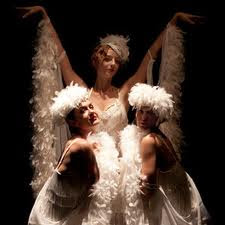Liz Lea and Co
The Street Theatre
19 & 20 May
What a mammoth effort this is from Liz Lea and what a
shame there were only two performances.
Inspired by the travels of Anna Pavlova’s company through
Australia and India with her collection of 120 birds, Canberra based performer Lea has put together a fictional touring dance troupe, Company Elle. Here
she recounts their travels, loves and lives, stories and adventures, spanning
almost a century and including reference to historical events and characters.
This is a jigsaw puzzle that chops and changes from the
present to a flashback, to flashforwards where the troupe is represented in a
really lovely touch, when older versions of themselves dance with their characters.
One of the ladies, Madeleine Bullock, has been directly influenced by Ruth St.
Denis’ dance practices, (St. Denis is one of the figures referenced in the
show). Another dancer, Glenys Harris, trained under Pavlova’s niece. Charmaine
Hallam and Toni Allen were trained in the Cecchetti style of ballet.
Company Elle consists of Lea, Ash Bee, Melanie Palomares and Miranda Wheen. Wheen is perfect as Lola, embodying the brash and
seductive trailblazer. Her dancing was a convincing mix of the masculine
sexuality demanded by the role and great technique. Her duets with Palomares were lovely.
Lea has collated and edited footage from the National
Sound and Film Archive of the Ballet Russes, old-fashioned beach parades, swimming drills,
modelling and dance-clips to name a few. She presents this amusing footage,
edited to be even more so, with hilarious explanations. Those nearer the back
of the theatre may have struggled to hear her in parts, this being the
challenge of regulating sound between live theatre and archival footage.
Unfortunately the appearance of the ANU homepage over the footage that made a
couple of brief appearances may have provided unintended laughs but broke the
vibe.
The dancing was intermittent and on leaving the theatre I
overheard a couple of comments that there wasn’t “enough” dancing. But the
dancing on display from Company Elle was reassured and dynamic. It would have been fitting to see a classical
piece danced by one of the girls after the death of Pavlova was spoken about.
This was a lovely part of the show.
The guest burlesque dancers needed to tighten up their
timing and stretch themselves on their technique and balance more than they did
in Saturday’s performance.
The last segment of the show, whilst charming, could have
been more tightly edited. The performance was somewhat eclectic in that it
becomes interactive with the audience, and hereby allows any slight hiccups to
be poked fun of. Lea seems quite capable of adlibbing and the humour in the
show is bold,off-beat and funny indeed. None of these minor gripes really detracted from the kaleidoscope
of gorgeous dresses, vintage underwear, poignant sentiments, and well executed
dance sequences. The burlesque numbers, with some very interesting headwear,
explained as a tribute to the headgear worn by Canberra cyclists were very
entertaining. This was a thoroughly lovable and engrossing show and a credit to
Lea. This slice of fictional history, with its footage and originality in
concept and staging is well worth seeing. Hopefully this extraordinary work
will get more stage-time in the near future.
+Brian+Geach.jpg)
Brian+Geach.jpg)
+Brian+Geach.jpg)
+and+Sid+(Alex+Rathgeber)+in+AN+OFFICER+AND+A+GENTLEMAN+2(c)Brian+Geach.jpg)
+Brian+Geach.jpg)
















